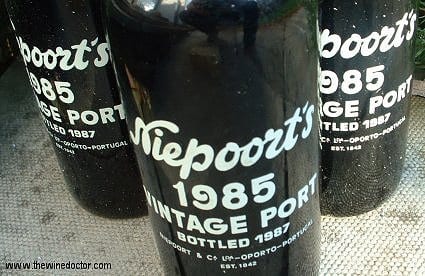Niepoort’s Vintage Port 1985
After last week’s port imbibing, which featured a small collection of elderly and in some cases deceased wines, I couldn’t resist pulling one of the much younger wines from my own cellar. As I alluded in my introduction to that tasting, one of the most common vintages to be found in my cellar is the 1985, so much so that I could in fact put on a half-decent horizontal tasting.
The modern wine that we know as port has an interesting history, which begins in the 16th Century with the English trading vessels that ran between Portugal and England, carrying oil, wine and fruit from the former and exchanging their cargoes for cloth, cotton and salt at the latter. As the trade increased, merchants ventured deeper and deeper into the inhospitable interior to source their wines; as a result they opened up the Douro, and many of them established their vineyards there. The red wine was probably of a coarse, rustic nature, but over the centuries that followed the quality and the style evolved into the sweeter, fortified one that we now regard as port. The fortification with brandy was originally used to stabilise the wine as it was transported downriver from the vineyards to Oporto, and from there to England, but with time it became the accepted and preferred style. Even so, as recently as the 19th Century there have been outspoken opponents to this blatant manipulation, with Joseph James Forrester being one of the most vocal, describing the practice as adulteration in 1844.

Thankfully Forrester’s belief that port should be a natural, unfortified product never took hold, otherwise we would be without this unique wine today. Nevertheless, although the world would be a poorer place without a glass of port, I do accept that the Douro, and no doubt other regions of Portugal, are more than adequate for the production of high-quality table wine. Indeed, many local estates, including some port houses, have demonstrated this by turning out some excellent unfortified table wines. One such house is that owned by Dirk Niepoort, and this week’s wine is one of his traditional styles, the Niepoort Vintage Port 1985.
The wine has a lovely colour, showing a little maturity but obviously, at only 21 years of age, plenty of red pigment and depth yet. The nose, however, is startling; it has a pervasive aroma of polystyrene cement which I have only encountered in such a forceful fashion in one or two wines before, namely Château de Beaucastel 1995 when caught at clearly an awkward moment in its evolution in a 1995 Rhône tasting, and the occasional vintage of Chateau Musar. This is volatile acidity at its most pungent, and it is a characteristic not entirely welcome in this bottle of Niepoort; thankfully it fades over the course of the evening, and the next day it is just a distant note on the nose, which reveals more interesting and worthy aromas of dried plums, cherries and even a little raspberry fruit, with nuances of dry, burnt wood. Very traditionally styled, and beautifully fresh and vibrant. On the palate it is certainly approachable, and currently straddles the phases of youthful fruit and maturity; perhaps not at peak, depending on your view of when vintage port should be drunk, but certainly fine now to my palate. Nicely integrated tannins, providing an appealing bitter, charcoaly structure to the roasted raspberry fruit. The texture even has a little evolving silkiness, although it is full and clearly the wine has great potential for continued improvement in the cellar, especially with such well poised acidity. Very good indeed, with great potential. 17.5+/20 (30/10/06)
